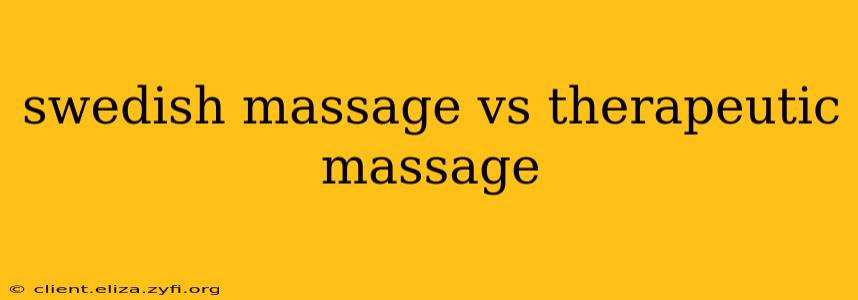Choosing the right type of massage can significantly impact your well-being. While both Swedish and therapeutic massage aim to improve your health, they differ in their techniques, goals, and intensity. This comprehensive guide will clarify the distinctions between these popular massage therapies, helping you make an informed decision for your specific needs.
What is Swedish Massage?
Swedish massage is the most common type of massage in the Western world. It's known for its gentle, flowing strokes that aim to relax muscles and promote overall well-being. This technique focuses on superficial muscles and uses long, gliding strokes, kneading, and circular movements to increase circulation, reduce muscle tension, and improve lymphatic drainage. It's often considered a relaxing and restorative experience, making it ideal for stress reduction and promoting relaxation.
What is Therapeutic Massage?
Therapeutic massage is a broader term encompassing various massage techniques designed to address specific health concerns. Unlike Swedish massage, which primarily focuses on relaxation, therapeutic massage targets deeper muscle layers and addresses issues like muscle pain, injury recovery, and postural problems. Techniques used in therapeutic massage can include deep tissue massage, trigger point therapy, myofascial release, and sports massage, depending on the individual's needs and the therapist's expertise. The goal is to alleviate pain, improve range of motion, and address the root cause of musculoskeletal issues.
What are the Key Differences Between Swedish and Therapeutic Massage?
The primary difference lies in the intensity and depth of the massage. Swedish massage is generally lighter and more superficial, focusing on relaxation and improving circulation. Therapeutic massage, on the other hand, can be more intense and go deeper into the muscle tissue, addressing specific problems and pain points.
Here's a table summarizing the key differences:
| Feature | Swedish Massage | Therapeutic Massage |
|---|---|---|
| Intensity | Light to moderate | Moderate to deep |
| Depth | Superficial | Deep |
| Goal | Relaxation, stress reduction, improved circulation | Pain relief, injury recovery, improved range of motion |
| Techniques | Long strokes, kneading, circular movements | Deep tissue, trigger point therapy, myofascial release, sports massage |
| Ideal For | Stress relief, general relaxation | Muscle pain, injury recovery, chronic conditions |
How Deep is Therapeutic Massage?
The depth of therapeutic massage varies greatly depending on the specific technique and the individual's needs and tolerance. Some techniques, like deep tissue massage, focus on releasing tension in deep muscle layers, which can feel quite intense. Others, such as trigger point therapy, target specific points of muscle tension. Your therapist will tailor the pressure and depth to your comfort level and the specific goals of the treatment.
Is Therapeutic Massage Painful?
While therapeutic massage aims to alleviate pain, some techniques, particularly deep tissue work, can cause temporary discomfort during the session. However, this discomfort shouldn't be unbearable. A good therapist will always check in with you and adjust the pressure as needed to ensure your comfort. The post-massage feeling is typically one of relief and relaxation, even if some soreness may be present for a short time afterward.
Which Type of Massage is Right for Me?
The best type of massage for you depends on your individual needs and goals.
- Choose Swedish massage if: You're looking for relaxation, stress reduction, and general well-being.
- Choose therapeutic massage if: You're experiencing muscle pain, recovering from an injury, have chronic pain, or need help with specific musculoskeletal problems.
Ultimately, consulting with a qualified massage therapist is crucial to determine the most appropriate type of massage for your specific condition and health goals. They can assess your needs and recommend the best approach to achieve optimal results.
